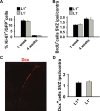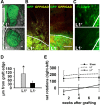Neural cell adhesion molecule L1-transfected embryonic stem cells promote functional recovery after excitotoxic lesion of the mouse striatum
- PMID: 17093074
- PMCID: PMC6674779
- DOI: 10.1523/JNEUROSCI.2688-06.2006
Neural cell adhesion molecule L1-transfected embryonic stem cells promote functional recovery after excitotoxic lesion of the mouse striatum
Abstract
We have generated a murine embryonic stem cell line constitutively expressing L1 at all stages of neural differentiation to investigate the effects of L1 overexpression on stem cell proliferation, migration, differentiation, cell death, and ability to influence drug-induced rotation behavior in an animal model of Huntington's disease. L1-transfected cells showed decreased cell proliferation in vitro, enhanced neuronal differentiation in vitro and in vivo, and decreased astrocytic differentiation in vivo without influencing cell death compared with nontransfected cells. L1 overexpression also resulted in an increased yield of GABAergic neurons and enhanced migration of embryonic stem cell-derived neural precursor cells into the lesioned striatum. Mice grafted with L1-transfected cells showed recovery in rotation behavior 1 and 4 weeks, but not 8 weeks, after transplantation compared with mice that had received nontransfected cells, thus demonstrating for the first time that a recognition molecule is capable of improving functional recovery during the initial phase in a syngeneic transplantation paradigm.
Figures






Similar articles
-
Embryonic stem cell-derived L1 overexpressing neural aggregates enhance recovery in Parkinsonian mice.Brain. 2010 Jan;133(Pt 1):189-204. doi: 10.1093/brain/awp290. Epub 2009 Dec 7. Brain. 2010. PMID: 19995872
-
Tenascin-R promotes neuronal differentiation of embryonic stem cells and recruitment of host-derived neural precursor cells after excitotoxic lesion of the mouse striatum.Stem Cells. 2008 Aug;26(8):1973-84. doi: 10.1634/stemcells.2007-0929. Epub 2008 May 22. Stem Cells. 2008. PMID: 18499893
-
Cross-talk between stem cells and the dysfunctional brain is facilitated by manipulating the niche: evidence from an adhesion molecule.Stem Cells. 2009 Nov;27(11):2846-56. doi: 10.1002/stem.227. Stem Cells. 2009. PMID: 19785036
-
Reconstruction of cortical circuitry.Prog Brain Res. 2000;127:115-56. doi: 10.1016/s0079-6123(00)27008-8. Prog Brain Res. 2000. PMID: 11142025 Review. No abstract available.
-
The 'current state of play' in transplantation and restoration research of the CNS.Neurotox Res. 2007 Apr;11(3-4):145-50. doi: 10.1007/BF03033564. Neurotox Res. 2007. PMID: 17449456 Review.
Cited by
-
Embryonic stem cell-derived L1 overexpressing neural aggregates enhance recovery after spinal cord injury in mice.PLoS One. 2011 Mar 18;6(3):e17126. doi: 10.1371/journal.pone.0017126. PLoS One. 2011. PMID: 21445247 Free PMC article.
-
Oxygen levels and the regulation of cell adhesion in the nervous system: a control point for morphogenesis in development, disease and evolution?Cell Adh Migr. 2012 Jan-Feb;6(1):49-58. doi: 10.4161/cam.19582. Cell Adh Migr. 2012. PMID: 22647940 Free PMC article. Review.
-
Analysis of human embryonic stem cells with regulatable expression of the cell adhesion molecule l1 in regeneration after spinal cord injury.J Neurotrauma. 2014 Mar 15;31(6):553-64. doi: 10.1089/neu.2013.2886. J Neurotrauma. 2014. PMID: 24125017 Free PMC article.
-
Induced Pluripotent Stem Cell-Derived Neural Stem Cell Transplantations Reduced Behavioral Deficits and Ameliorated Neuropathological Changes in YAC128 Mouse Model of Huntington's Disease.Front Neurosci. 2017 Nov 10;11:628. doi: 10.3389/fnins.2017.00628. eCollection 2017. Front Neurosci. 2017. PMID: 29209158 Free PMC article.
-
GABAergic neurons from mouse embryonic stem cells possess functional properties of striatal neurons in vitro, and develop into striatal neurons in vivo in a mouse model of Huntington's disease.Stem Cell Rev Rep. 2012 Jun;8(2):513-31. doi: 10.1007/s12015-011-9290-2. Stem Cell Rev Rep. 2012. PMID: 21720791
References
-
- Barbin G, Aigrot MS, Charles P, Foucher A, Grumet M, Schachner M, Zalc B, Lubetzki C. Axonal cell-adhesion molecule L1 in CNS myelination. Neuron Glia Biol. 2004;1:65–72. - PubMed
-
- Bosch M, Pineda JR, Sunol C, Petriz J, Cattaneo E, Alberch J, Canals JM. Induction of GABAergic phenotype in a neural stem cell line for transplantation in an excitotoxic model of Huntington's disease. Exp Neurol. 2004;190:42–58. - PubMed
-
- Chen J, Bernreuther C, Dihné M, Schachner M. Cell adhesion molecule L1-transfected embryonic stem cells with enhanced survival support regrowth of corticospinal tract axons in mice after spinal cord injury. J Neurotrauma. 2005;22:896–906. - PubMed
-
- Chen S, Mantei N, Dong L, Schachner M. Prevention of neuronal cell death by neural adhesion molecules L1 and CHL1. J Neurobiol. 1999;38:428–439. - PubMed
Publication types
MeSH terms
Substances
LinkOut - more resources
Full Text Sources
Medical
